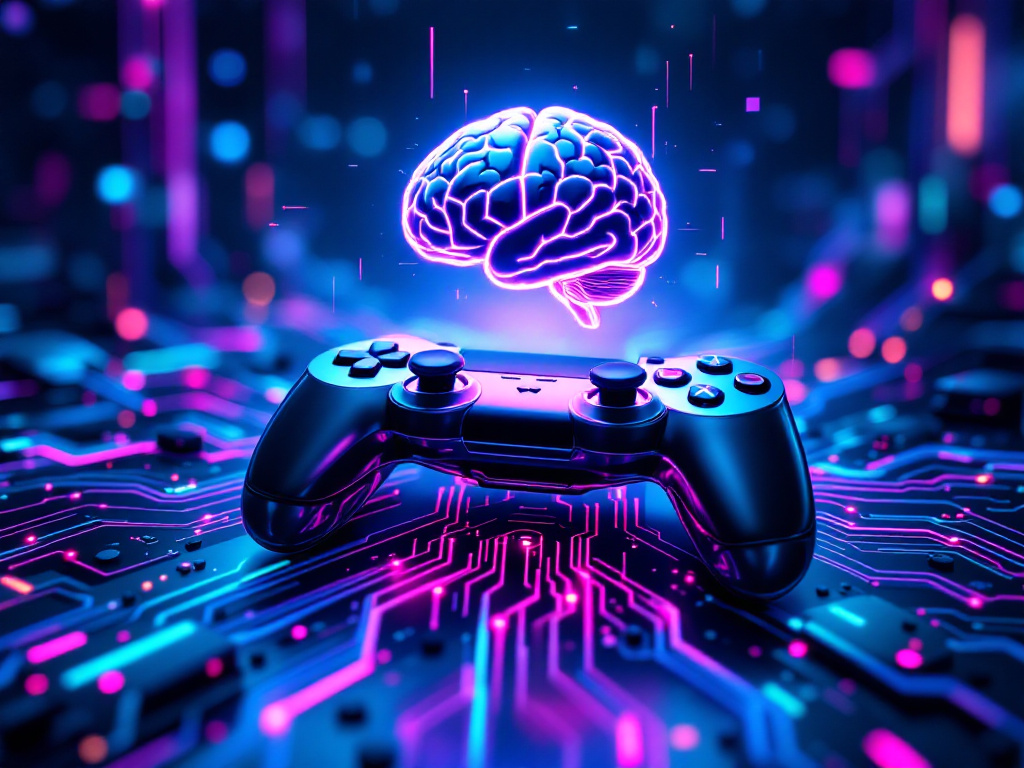Game development has come a long way. In the early days, games were simple. Most featured blocks or basic pixel art. Today, they offer vast worlds and complex storylines. They have advanced graphics and realistic physics. But there’s another revolution happening now. Artificial Intelligence (AI) is transforming how games are made. This technology is shaking up the industry in big ways. From smarter enemies to adaptive game mechanics, AI is changing the future of game dev. Below is a detailed look at this exciting shift.
Introduction
The world of video games has come a long way since the early days of simple graphics and basic gameplay. From the pixelated adventures of the 1980s to the lifelike simulations of today, one thing has been clear: technology drives innovation in gaming. Among the most significant technological advancements is Artificial Intelligence (AI). AI in game development is transforming the industry, enabling developers to create more immersive and dynamic experiences.
In this comprehensive overview, we will explore how AI is revolutionizing game development. We’ll look at its historical evolution, discuss key AI techniques like machine learning and neural networks, examine real-world examples from both major studios and indie developers, and consider future trends and challenges facing the industry.
Historical Evolution of AI in Games
The Early Days
In the earliest video games, AI was rudimentary. Classic arcade games like “Space Invaders” (1978) featured enemy ships that moved in predetermined patterns. The AI was limited to simple if-then statements, causing enemies to react in basic ways. These early AI implementations provided predictable challenges but lacked complexity.
The Rise of More Complex Behaviors
In the 1990s, games began to feature more sophisticated AI. Titles like “GoldenEye 007” (1997) on the Nintendo 64 introduced enemies that could react to the player’s actions, seek cover, and work together. Developers started to use finite state machines to program more complex behaviors, allowing NPCs to switch between different states based on game conditions.
Introduction of AI Companions
With advancements in processing power, games could handle more detailed AI calculations. “Half-Life” (1998) showcased AI companions and enemies that could navigate the environment intelligently. NPCs could navigate around obstacles, follow the player, and perform tasks independently.
Advancements in the 2000s
- “Grand Theft Auto” Series: Introduced open-world environments where AI controls traffic, pedestrians, and law enforcement, creating a living city that reacts to player actions.
- “The Sims” (2000): Simulated daily life with AI characters that have needs, desires, and personalities, requiring players to manage and influence their behaviors.
Emergence of Online and Multiplayer AI
- “Left 4 Dead” (2008): The AI Director not only adjusts the game’s difficulty but also manages the placement of items and enemies, adapting to the performance of the players to maintain tension.
- “Dark Souls” Series: Features AI that learns from player behaviors, creating challenging and strategic combat scenarios.
Key AI Techniques in Modern Games
Machine Learning in Games
Machine learning allows AI systems to learn from data without being explicitly programmed. In gaming, this means AI can adapt to player behavior, learn new strategies, and provide a personalized experience.
- Adaptive Difficulty: AI can adjust the game’s difficulty based on the player’s skill level. For instance, if a player is struggling, the AI can reduce enemy aggressiveness.
- Player Behavior Analysis: Machine learning algorithms can analyze how players interact with the game, identifying patterns and preferences. This data can be used to tailor content or suggest in-game items.
Neural Networks and Deep Learning for NPCs
Neural networks, especially deep learning models, can process vast amounts of data and identify complex patterns. In game development, deep learning is used to create NPCs that behave more realistically.
- Natural Language Processing (NLP): NPCs can understand and respond to player commands using NLP, allowing for more natural interactions.
- Character Animations: Deep learning can generate realistic animations by learning from motion capture data, leading to smoother character movements.
Reinforcement Learning
An area of machine learning where AI learns by interacting with the environment and receiving feedback in the form of rewards or penalties.
- AI Opponents: Can develop strategies over time, learning optimal ways to challenge the player.
- Dynamic Environments: AI can modify the game world in response to player actions, creating a more immersive experience.
Procedural Content Generation (PCG)
AI algorithms create game content algorithmically rather than manually, including levels, maps, items, and quests.
- Infinite Content: Games like “Minecraft” and “Starbound” use PCG to create vast, explorable worlds.
- Cost Efficiency: Reduces the time and resources needed for content creation, allowing developers to focus on other aspects of the game.
AI for Emotion and Behavior Modeling
- Emotional AI: NPCs can display emotions based on in-game events, enhancing realism.
- Social AI: NPCs interact with each other, forming relationships, alliances, or rivalries that affect gameplay.
Game Engine AI
Modern game engines come equipped with powerful AI tools. These include:
- Pathfinding Algorithms: Such as A*, used to navigate NPCs through complex environments efficiently.
- Behavior Trees: A hierarchical model that controls NPC decision-making processes, allowing for more dynamic and responsive behaviors.
- Navigation Meshes: Define walkable areas in a game environment, enabling NPCs to move realistically.
Real-World Examples from AAA and Indie Studios
“Middle-earth: Shadow of Mordor” (2014) – The Nemesis System
One of the most innovative uses of AI in recent years is the Nemesis System. This system tracks encounters with enemy characters, who remember past interactions with the player. Enemies adapt, grow stronger, and even bear scars from previous battles.
- Dynamic Storytelling: Each player’s experience is unique, as the AI generates personalized enemies that react differently.
- Emergent Gameplay: Unexpected scenarios arise from the AI’s ability to adapt, increasing replay value.
“No Man’s Sky” (2016) – Procedural Universe Generation
An ambitious indie game that uses algorithms to create an entire universe consisting of over 18 quintillion planets.
- Procedural Content Generation: The AI generates planets, ecosystems, weather patterns, and even music on the fly.
- Exploration and Discovery: Players can explore endlessly, with each discovery being unique.
“Alien: Isolation” (2014) – Advanced Enemy AI
The AI in “Alien: Isolation” provides a terrifying experience by creating an enemy that learns from the player’s actions.
- Unpredictable Behavior: The alien doesn’t follow preset patterns, making each encounter suspenseful.
- AI Directors: The game uses an AI “director” to adjust the pacing, ensuring consistent tension throughout the game.
“Red Dead Redemption 2” (2018)
- Living World: Features an AI ecosystem where animals hunt, NPCs follow schedules, and the environment reacts dynamically to the player’s actions.
- Interactive NPCs: Players can engage with NPCs in various ways, influencing their responses and the game’s outcome.
“Detroit: Become Human” (2018)
- Branching Storylines: Uses AI to manage complex narrative pathways, resulting in multiple endings based on player choices.
- Emotionally Intelligent AI: Characters exhibit realistic emotions and make decisions that reflect their personalities and experiences.
“Microsoft Flight Simulator” (2020)
- Real-Time Data Integration: Uses AI to render real-world environments and weather patterns, creating a highly realistic simulation experience.
- AI Pilots and Traffic: Simulates air traffic and other pilots, adding to the immersion.
Indie Innovations
- “Hellblade: Senua’s Sacrifice” (2017): Utilized AI for voice recognition and to simulate psychosis, creating an immersive psychological experience.
- “Celeste” (2018): Implements an AI-assist mode that helps players by adapting controls, making the game accessible without reducing the challenge.
- “Into the Breach” (2018): Features AI-controlled enemies with predictable yet challenging behaviors, requiring strategic planning.
Future Trends and Challenges in AI Game Development
Enhanced Personalization and Player Experience
- Dynamic Storytelling: AI can create narratives that adapt to player choices, leading to truly personalized stories.
- Procedural Level Design: Levels generated by AI can offer endless variety and challenges tailored to the player’s skill level.
Advanced NPC Interactions
- Natural Conversations: With advancements in NLP, NPCs may engage in meaningful dialogues, understanding context and emotional nuances.
- Emotion Recognition: Games might detect player emotions through sensors or gameplay patterns, adapting the experience accordingly.
AI in Game Testing and Development
- Automated Testing: AI can simulate thousands of gameplay hours, identifying bugs and balancing issues more efficiently.
- Content Creation: AI tools assist developers by generating textures, models, and even music, speeding up the development process.
Virtual Reality (VR) and AI
- Immersive Experiences: AI can enhance VR by creating more responsive and realistic environments and characters.
- Haptic Feedback and Sensory AI: AI could manage sensory inputs, adjusting vibrations, sounds, and visuals to match gameplay.
Cross-Platform and Cloud Gaming
- AI Optimization: Cloud-based AI could offload processing from devices, allowing for more complex AI in games accessible on various platforms.
- Seamless Multiplayer Experiences: AI can manage matchmaking, player behavior moderation, and personalized game modes.
AI in Esports and Competitive Gaming
- Training Tools: AI can help players improve by analyzing gameplay and suggesting strategies.
- Spectator Experience: AI can enhance broadcasts by providing insights, live statistics, and dynamic camera angles.
Challenges and Ethical Considerations
- Data Privacy: With AI collecting data to personalize experiences, protecting player information is crucial.
- Balancing AI Difficulty: Ensuring that AI opponents are challenging but fair requires careful tuning.
- Uncanny Valley: As AI drives toward more lifelike characters, there’s a risk of creating unsettling or unnatural experiences.
- Fairness and Transparency: Ensuring AI does not create unfair advantages or disadvantage certain players.
- Regulation Compliance: Adhering to laws regarding data collection, especially with international player bases.
Technical Limitations
- Processing Power: Advanced AI can be resource-intensive, potentially impacting game performance.
- Accessibility: Smaller studios may lack the resources to implement cutting-edge AI, leading to disparities in game quality.
Additional Challenges
- AI Art and Copyright Issues: As AI generates content, questions arise about ownership and originality.
- Societal Impact: Games with advanced AI might influence player behavior or cultural perceptions, raising concerns over social responsibility.
What is AI in game development?
AI in game development refers to the use of artificial intelligence techniques to create responsive, adaptive, and intelligent behaviors in non-player characters (NPCs) and game environments. It enhances gameplay by making games more immersive and challenging.
How is machine learning used in games?
Machine learning enables games to learn from player actions and adapt accordingly. It can adjust difficulty levels, personalize content, and develop NPCs that improve their strategies over time, providing a tailored gaming experience.
What are examples of AI techniques used in modern games?
Common AI techniques include pathfinding algorithms like A*, behavior trees for decision-making, neural networks for realistic NPC behaviors, and procedural content generation to create dynamic game environments.
How does AI improve NPC behavior?
AI allows NPCs to act more realistically by enabling them to make decisions based on the game environment and player actions. They can learn, adapt, exhibit emotions, and interact with players in more natural and varied ways.
What is procedural content generation, and how does AI contribute?
Procedural content generation (PCG) is the automatic creation of game content using algorithms. AI contributes to PCG by generating levels, maps, items, and quests, allowing for endless variety and reducing the need for manual content creation.


1 thought on “How AI is Revolutionizing Game Development: #1 A Comprehensive Overview”